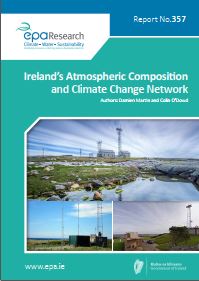Research 357: Ireland’s Atmospheric Composition and Climate Change Network
Authors: Damien Martin and Colin O’Dowd
Summary: The Atmospheric Composition and Climate Change network is a valuable established national research and monitoring infrastructure. This fellowship has enabled and sustained scientific work on a national monitoring network. Infrastructure has been continually developed over the course of the fellowship that will facilitate long-term sustainable measurements.

Project Highlights
Watch the project highlights video
The Atmospheric Composition and Climate Change network is a valuable established national research and monitoring infrastructure. It has been developed incrementally based on measurements of greenhouse gases (GHG’s) and short-lived climate forcers (SLCF’s) including aerosol/particulate matter (PM) chemical and physical characteristics in line with best practice from both pan-European and global monitoring programmes. GHG measurements are undertaken under the umbrella of the ICOS (Integrated Carbon Observing System) pan-European research infrastructure, while additional observations are conducted under the EMEP (Co-operative Programme for Monitoring and Evaluation of the Long-range Transmission of Air Pollutants in Europe). The report describes the operation, development and expansion of the network activities and infrastructure.
Identifying Pressures
The 2015 Paris Agreement established the global policy response to climate change. A key objective of that agreement is that global GHG emissions are balanced by removals from the atmosphere during the second half of this century. Achieving both national and global pathways will require an increased understanding of emissions and removals by sinks and the processes by which the latter can be enhanced. Measurements of GHGs can be used with modelling techniques to verify emission inventories and in particular to assess the balance of emissions and removals from the land sector.
Air pollution levels in Ireland are determined by local emissions and emissions in Europe, North America and further afield through the hemispheric transport of pollutants. Actions to address air pollution are taken at these levels and include the Convention on Long-range Transboundary Air Pollution (CLRTAP) and its protocols, which link to the EU Clean Air for Europe (CAFÉ) programme, including the National Emissions Ceiling Directive. EMEP is a programme under CLRTAP that addresses the requirement for Parties to the Convention to undertake air quality monitoring. A fundamental understanding of the nature, scope and magnitude of transboundary air pollution,
which is monitored using this network, is essential to understanding its relative source contribution and to supporting national and international efforts to improve air quality.
Informing Policy
A national GHG monitoring and analysis network, especially one linked to the ICOS European Research Infrastructure Consortium, can help to resolve fundamental questions relating to Ireland’s GHG emissions which can inform future climate change policy, for example:
- Reduce uncertainties in determining the nature and extent of the sources and sinks for GHG emissions and removals in Ireland.
- Assess how meteorological and other factors influence these sinks over timescales ranging from seasons to decades and the interplay between these and management systems.
- Highlight geographical areas with high levels of uncertainty in bottom-up analysis of gases such as nitrous oxide and methane.
- Produce an independent integrated and comprehensive analysis of emissions and removals in Ireland in the context of meeting the goal of climate neutrality.
Monitoring of aerosol chemical and physical characteristics and other SLCFs can be used to elucidate transboundary air pollution and underpin national and international monitoring and response strategies.
Developing Solutions
This fellowship has enabled and sustained scientific work on a national monitoring network. Infrastructure has been continually developed over the course of the fellowship that will facilitate long-term sustainable measurements. Given the national and international importance of climate change, it is critical to maintain a level of investment in infrastructure, analytical systems and associated complimentary measurements to ensure that Ireland is at the forefront of this critical area in order to inform policy and facilitate meaningful solutions. Ireland is already at the forefront of GHG and transboundary air pollution monitoring. Further developing the inversion modelling techniques to include SLCFs would be an important extension of network capability, particularly in the areas of source apportionment and emission verification. Robust source apportionment of air pollution is essential to understand the complex nature of its sources and identify where to target policies to improve air quality and maximise societal benefit.
https://www.epa.ie/media/epa-2020/publications/research/Thumbnail_357.jpg